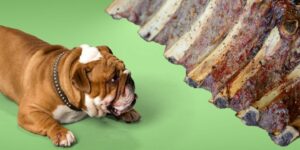Overview of the topic
The short answer is yes, dogs can eat bones. In fact, bones can provide several nutritional benefits for dogs, including helping to maintain healthy teeth and gums. However, it is important to give your dog the right type and size of the bone and to monitor them while they are chewing to prevent any potential choking hazards or other issues.
Importance of understanding the benefits and risks of giving bones to dogs
As a dog owner, it is crucial to be informed about the advantages and potential risks associated with giving bones to your dog. In this article, we will discuss the nutritional benefits of bones for dogs, how to choose the appropriate bone, potential hazards, monitoring your dog while they chew, and some alternatives to bones.
Nutritional Benefits of Bones for Dogs
Protein and fat content
Bones are a natural source of protein and fat, which are essential components of a dog's diet. These nutrients help to support healthy muscles, skin, and coat.
Calcium and other essential minerals
Bones also provide a source of calcium and other vital minerals, including phosphorus and magnesium. These minerals contribute to the development and maintenance of your dog's skeletal system, muscles, and nervous system.
Dental health benefits
Plaque and tartar removal
Chewing on bones can help to scrape away plaque and tartar from your dog's teeth, promoting overall dental health. Keeping your dog's teeth clean can help prevent gum disease, tooth decay, and bad breath.
Strengthening of teeth and gums
Chewing on bones can also strengthen your dog's teeth and gums, reducing the risk of oral health issues in the long run.
Mental stimulation and behavioral benefits
Bones provide mental stimulation for dogs, keeping their minds active and engaged. Moreover, chewing on bones can serve as an outlet for their innate need to chew, preventing boredom and helping to minimize destructive behaviors.
Choosing the Right Type and Size of Bone for Your Dog
Unsafe bones for dogs
Cooked bones
Cooked bones are more likely to splinter and cause internal injuries, so they should be avoided.
Small, brittle bones
Small, brittle bones can easily break into sharp pieces, posing a choking hazard and increasing the risk of internal injury.
Safe bones for dogs
Raw bones
Raw bones are more pliable and less likely to cause harm compared to cooked bones.
Size-appropriate bones
Choose bones that are appropriately sized for your dog, with smaller bones for small dogs and larger bones for large dogs.
Examples for small dogs
For small dogs, try chicken necks, wings, or beef ribs.
Examples for large dogs
For large dogs, consider beef knuckle bones, whole lamb shanks, or turkey necks.
Duration of use and disposal
Dispose of the bone after three to four days of use, as bacteria can develop over time. Regularly replace bones to ensure freshness and cleanliness.
Potential Risks and Hazards of Giving Bones to Dogs
Choking hazards
Bones can pose a choking hazard, particularly if your dog is consuming a bone that is too small or brittle.
Splintering and internal injuries
As mentioned earlier, cooked bones and small, brittle bones can splinter and cause internal injuries.
Digestive issues
Some dogs may experience digestive upset or constipation from consuming bones.
Bacterial contamination
Raw bones may carry bacteria, such as salmonella, which can lead to illness in both your dog and humans in the household. Handling and storing raw bones properly can minimize these risks.
Monitoring Your Dog While They Are Chewing on Bones
Signs of distress or difficulty
Keep a close eye on your dog while they are chewing on a bone, looking out for any signs of distress or difficulty, such as gagging or excessive pawing at their mouth.
Appropriate intervention
If your dog appears to be struggling with the bone or seems uncomfortable, remove the bone immediately and consult with your veterinarian.
When to consult with a veterinarian
If your dog is vomiting, has diarrhea, is lethargic, or shows any other signs of illness after consuming a bone, contact your veterinarian right away.
Alternatives to Bones for Dogs
Dental chews and toys
Dental chews and toys designed specifically for dogs can also help clean their teeth while providing a safe chewing outlet.
Natural alternatives (e.g., antlers, bully sticks)
Natural alternatives like antlers and bully sticks can offer similar benefits to bones while posing fewer risks.
Homemade chew options
Some dog owners opt to create homemade chew toys using items like frozen carrot sticks, which can also help satisfy a dog's chewing instincts.
Conclusion
In conclusion, dogs can safely eat bones as long as the right type and size of bone is chosen and the dog is properly monitored while chewing. Bones can provide several nutritional benefits for dogs, including helping to maintain healthy teeth and gums. However, it is important to consult with your veterinarian if you have any concerns about giving your dog bones to chew on, and consider alternatives if necessary.











